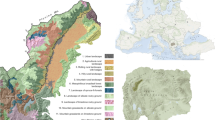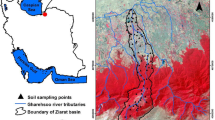Abstract
Sandy beaches are central economic assets, attracting more recreational users than other coastal ecosystems. However, urbanization and landscape modification can compromise both the functional integrity and the attractiveness of beach ecosystems. Our study aimed at investigating the relationship between sandy beach artificialization and the landscape perception by the users, and between sandy beach visual attractiveness and biodiversity. We conducted visual and biodiversity assessments of urbanized and semiurbanized sandy beaches in Brazil and Uruguay. We specifically examined meiofauna as an indicator of biodiversity. We hypothesized that urbanization of sandy beaches results in a higher number of landscape detractors that negatively affect user evaluation, and that lower-rated beach units support lower levels of biodiversity. We found that urbanized beach units were rated lower than semiurbanized units, indicating that visual quality was sensitive to human interventions. Our expectations regarding the relationship between landscape perception and biodiversity were only partially met; only few structural and functional descriptors of meiofauna assemblages differed among classes of visual quality. However, lower-rated beach units exhibited signs of lower environmental quality, indicated by higher oligochaete densities and significant differences in meiofauna structure. We conclude that managing sandy beaches needs to advance beyond assessment of aesthetic parameters to also include the structure and function of beach ecosystems. Use of such supporting tools for managing sandy beaches is particularly important in view of sea level rise and increasing coastal development.







Similar content being viewed by others
References
Alves ES, Pezzuto PR (2009) Effect of morphodynamics on annual average zonation pattern of benthic macrofauna of exposed sandy beaches in Santa Catarina, Brazil. Braz J Oceanogr 57(3):189–203. doi:10.1590/S1679-87592009000300003
Alves AS, Adão H, Ferrero TJ, Marquesa JC, Costa MJ, Patrício J (2013) Benthic meiofauna as indicator of ecological changes in estuarine ecosystems: the use of nematodes in ecological quality assessment. Ecol Indic 24:462–475. doi:10.1016/j.ecolind.2012.07.013
Anderson MJ, Gorley RN, Clarke KR (2008) PERMANOVA + for Primer: Guide to software and statistical methods. Primer-E, Plymouth
Barrett K, Anderson WB, Wai DA, Grismer LL, Polis GA, Rose MD (2005) Marine subsidies alter the diet and abundance of insular and coastal lizard populations. Oikos 109:145–153
Bell S (2001) Landscape pattern, perception and visualisation in the visual management of forests. Land Urban Plan 54:201–211
Bongers T, Alkemade R, Yeates GW (1991) Interpretation of disturbance-induced maturity decrease in marine nematode assemblages by means of the maturity index. Mar Ecol Prog Ser 76:135–142
Botero CM, Willians AT, Cabrera JA (2013) Advances in beach management in Latin America: overview from certification schemes. In: Finkl CW, Makowski C (eds) Environmental management and governance: advances in coastal and marine resources, vol 33. Springer, New York, pp 33–66
Cervantes O, Espejel I, Arellano E, Delhumeau S (2008) Users’ perception as a tool to improve urban beach planning and management. Environ Manag 42(2):249–264
Clarke KR, Ainsworth M (1993) A method of linking multivariate community structure to environmental variables. Mar Ecol Progr 92:205–219
Daniel TC (2001) Whitherscenic beauty? Visual landscape quality assessment in the 21st century. Land Urban Plan 54:267–281
Defeo O, McLachlan A, Schoeman DS, Dugan J, Jones A, Lastra M, Scapini F (2009) Threats to sandy beach ecosystems: a review. Estuar Coast Shelf Sci 81:1–12
Duck RW, Phillips MR, Williams AT, Wadham TA (2009) Is beach scenic quality a function of habitat diversity? J Coast Res SI56:415–418
Dugan JE, Hubbard DM, McCrary MD, Pierson MO (2003) The response of macrofauna communities and shorebirds to macrophyte wrack subsidies on exposed sandy beaches of southern California. Estuar Coast Shelf Sci 58:133–148. doi:10.1016/S0272-7714(03)00045-3
Dugan JE, Hubbard DM, Rodil I, Revell DL, Schroeter S (2008) Ecological effects of coastal armoring on sandy beaches. Mar Ecol 29:160–170. doi:10.1111/j.1439-0485.2008.00231.x
Duvat V (2012) Public perception of beach quality: lessons learnt from a French case study. Santa Marta, Colombia. HAL Id: hal-00821861. https://hal.archives-ouvertes.fr/hal-00821861/document
Gheskiere T, Hoste E, Vanaverbeke J, Vincx M, Degraer S (2004) Horizontal zonation patterns and feeding structure of marine nematode assemblages on a macrotidal, ultra-dissipative sandy beach (De Panne, Belgium). J Sea Res 52(3):211–226
Gheskiere T, Vincx M, Weslawski JM, Scapini F, Degraer S (2005) Meiofauna as descriptor of tourism-induced changes at sandy beaches. Mar Environ Res 60(2):245–265
Giere O (2009) Meiobenthology. The microscopic motile fauna of aquatic sediments. Springer, Berlin
Giere O, Pfannkuche O (1982) Biology and ecology of marine Oligochaeta, a review. Oceanogr Mar Biol Ann Rev 20:173–308
Gobster PH (1999) An ecological aesthetic for forest landscape management. Landsc J 18:54–64
González SA, Yáñez-Navea K, Muñoz M (2014) Effect of coastal urbanization on sandy beach coleoptera Phaleria maculata (Kulzer, 1959) in northern Chile. Mar Pollut Bull 83:265–274
Harris L, Campbell EE, Nel R, Scho-eman DS (2014) Rich diversity, strong endemism, but poor protection: addressing the neglect of sandy beach eco-systems in coastal conservation planning. Divers Distrib 20:1120–1135
Heip C, Vincx M, Vranken G (1985) The ecology of marine nematodes. Oceanogr Mar Biol Ann Rev 23:399–489
Hennig HFKO, Fricke AH, Martin CT (1983) The effect of meiofauna and bacteria on nutrient cycles in sandy beaches. In: McLachlan A, Erasmus T (eds) Sandy beaches as ecosystems. The Hague, Port Elizabeth, pp 235–248
Huijibers CM, Schlacher TA, Schoeman DS, Westone MA, Connolly RM (2013) Urbanisation alters processing of marine carrion on sandy beaches. Landsc Urban Plan 119:1–8
IBGE Instituto Brasileiro de Geografia e Estatística (2014) Estimativas da população residente com data de referência 1º de julho de 2014 publicadas no Diário Oficial da União. http://www.ibge.gov.br/home/estatistica/populacao/estimativa2014/estimativa_dou.shtm. Accessed 8 July 2014
IMM Intendencia Municipal de Montevideo (2011) Pocitos. http://www.montevideo.gub.uy/ciudad/historia/barrios/pocitos. Accessed 8 July 2014
Kurz T, Baudains C (2012) Biodiversity in the front yard: an investigation of landscape. Environ Behav 44:166–196
Loures L, Loures A, Nunes J, Panagopoulos T (2015) Landscape valuation of environmental amenities throughout the application of direct and indirect methods. Sustainability 7:794–810
Maguire GS, Miller KK, Weston MA, Young K (2011) Being beside the seaside: beach use and preferences among coastal residents of south-eastern Australia. Ocean Coast Manag 54:781–788
McLachlan A, Brown AC (2006) The Ecology of Sandy Shores. Elsevier, San Diego
McLachlan A, Jaramillo E (1995) Zonation on sandy beaches. Oceanogr Mar Biol Ann Rev 33:305–335
Micallef A, Morgan R, Williams AT (1999) User preferences and priorities on Maltese beaches: findings and potential importance for tourism. In: Randazzo G (ed) CDROM: coastal environmental management. EUCC-Italy/EUCC
Moellmann AM, Corbisier TN (2003) Does tourist flow affect the meiofauna of sandy beaches? Preliminary results. J Coast Res 35:590–598
Netto SA, Meneghel A (2014) Pulse of marine subsidies: the role of surf diatom Asterionellopsis glacialis accumulations in structuring the meiofauna of sandy beaches. Mar Biodiv 44:445–457
Neumann B, Vafeidis AT, Zimmermann J, Nicholls RJ (2015) Future coastal population growth and exposure to sea-level rise and coastal flooding—a global assessment. PLoS One 10(3):e0118571
Nicholas WL, Hodda M (1999) The free-living nematodes of a temperate, high energy, sandy beach, faunal composition and variation over space and time. Hydrobiologia 394:113–127
Nordstrom KF (2000) Beaches and dunes on developed coasts. Cambridge University Press, Cambridge
Nordstrom KF, Lampe R, Vandemark LM (2000) Re-establishing naturally functioning dunes on developed coasts. Environ Manag 25:37–51
Noriega R, Schlacher TA, Smeuninx B (2012) Reductions in ghost crab populations reflect urbanization of beaches and dunes. J Coast Res 28(1):123–131
Qiu L, Lindberg S, Nielsen AB (2013) Is biodiversity attractive? On-site perception of recreational and biodiversity values in urban green space. Landsc Urb Plan 119:136–146
Rangel-Buitrago N, Anfuso G, Ergyn A, Williams AT (2012) Evaluación de paisaje escénico costero mediante el uso de la lógica matemática: aplicación en la zona costera de la Sierra Nevada de Santa Marta—Caribe Colombiano. Costas 1:181–195
Rodriguez JG, Lastra M, Lopez J (2003) Meiofauna distribution along a gradient of sandy beaches in northern Spain. Estuar Coast Shelf Sci 58:63–69
Salvat B (1964) Les conditions hydrodynamiques interstitielles des sédiments meubles intertidaux et la répartition verticale de la faune endogenée. C R Acad Sci Paris 259:1576–1579
Schlacher TA, Thompson L (2012) Beach recreation impacts benthic invertebrates on ocean-exposed sandy shores. Biol Conserv 147(1):123–132. doi:10.1016/j.biocon.2011.12.022
Semeoshenkova VS, Williams AT (2011) Beach quality assessment and management in the Sotavento (Eastern) Algarve, Portugal. J Coast Res SI 64:1282–1286
Silveira LF, Klein AH, Tessler MG (2011) Classificação morfodinâmica das praias do estado de Santa Catarina e do litoral norte do estado de São Paulo utilizando sensoriamento remoto. Braz J Aquat Sci Technol 15(2):13–28
Somerfield PJ, Warwick RM, Moens T (2005) Meiofauna Techniques. In: Eleftheriou A, McIntyre A (eds) Methods for the study of marine benthos, 3rd edn. Blackwell, Oxford, pp 229–272
Spalding MD, Fox HE, Allen GR, Davidson N, Ferdana ZA, Finlayson M, Halpern BS, Jorge MA, Lombana A, Lourie SA, Martin KD, McManus E, Molnar J, Recchia CA, Robertson J (2007) Marine ecoregions of the world: a bioregionalization of coastal and shelf areas. Bioscience 57:573–583
Unal O, Williams AT (1999) Beach visits and willingness to pay: Cesme peninsula, Turkey. In: Ozhan E (ed) Proceedings of the Medcoast–EMECS 99 Joint Conference, Landscape Ocean Interactions: Managing Coastal Ecosystems, Ankara, pp 1149–1162
Wang J, Zhou H, Zhang Z, Cong B, Xu S (2011) Effects of organic enrichment on sandy beach meiofauna: a laboratory microcosm experiment. J Ocean Univ China 10:246–254. doi:10.1007/s11802-011-1831-4
Williams K, Cary J (2002) Landscape preferences, ecological quality and biodiversity protection. Environ Behav 34(2):257–274
Zeppilli D, Sarrazin J, Leduc D, Arbizu PM et al (2015) Is the meiofauna a good indicator for climate change and anthropogenic impacts? Mar Biodiv 45:505–535
Zielinski S, Botero C (2015) Are eco-labels sustainable? Beach certification schemes in Latin America and the Caribbean. J Sustain Tuor 23:1550–1572
Acknowledgments
This work was partially supported by the CAPES Foundation (Ministry of Education). G. Felix was supported by CAPES, and M. Polette and S.A. Netto were supported by the Brazilian Research Council (CNPq). We thank Daniel Conde (Universidad de la República, Uruguay) and Paulo Pezzuto (Universidade do Vale do Itajaí, Brazil) for the constructive comments and suggestions. R. Gingold (sweepandmore.com) is thanked for the critical reading and editing of the manuscript. We are indebted to the anonymous referees for their helpful comments and suggestions.
Author information
Authors and Affiliations
Corresponding author
Electronic supplementary material
Below is the link to the electronic supplementary material.
Rights and permissions
About this article
Cite this article
Felix, G., Marenzi, R.C., Polette, M. et al. Landscape Visual Quality and Meiofauna Biodiversity on Sandy Beaches. Environmental Management 58, 682–693 (2016). https://doi.org/10.1007/s00267-016-0735-x
Received:
Accepted:
Published:
Issue Date:
DOI: https://doi.org/10.1007/s00267-016-0735-x




